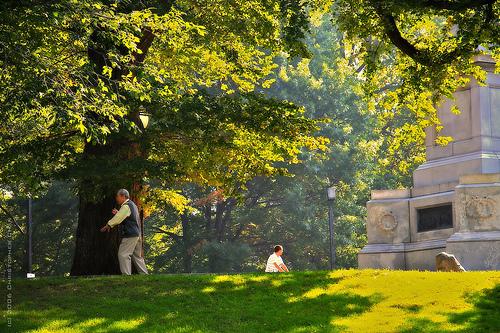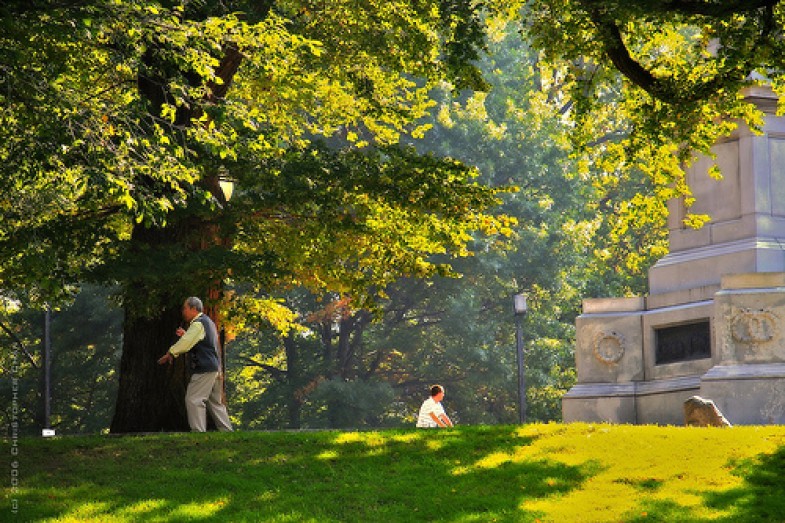The following essay is reprinted from the South End News, December 4, 2008, with permission.
Beware of public-private partnerships formed to “rescue” public spaces. They typically start with a manufactured crisis of safety and/or funding; this is used to justify the handover of the space to private “benefactors” who then reap far more than they contribute while they take control of the public realm. Unless we are vigilant, the Boston Common, America’s first public park, is about to be rescued.
Councilors Michael Ross, Bill Linehan and Sal LaMattina have created a City Council Special Committee for the Boston Common, focusing on concerns about public safety and “quality of life.” It appears that abutting residents, businesses, and institutions who consider the Boston Common their front yard are displeased with the “negative activities” in the park. Crime is under control, and drug-related activity has been largely displaced by policing, but the homeless “hanging around” in the park are apparently spoiling the park’s ambiance.

Photo by Christopher Chan, licensed under a Creative Commons Attribution, NonCommercial, No Derivatives Work license.
This is a problem especially for two rapidly expanding institutions, Suffolk University (Ross’s alma mater) and Emerson College, which already occupy over 30 buildings around the park. They want to carve out an attractive space in the inner city for their students, and to borrow the public landscape as part of their campus.
The Committee’s recently drafted recommendations focus on a trendy remedy – one unmentioned in its two public hearings: a private conservancy, made up of abutters and area institutions. As Councilor Linehan envisioned at the committee meeting reviewing the draft report, the conservancy would handle all the revenue-producing operations in the park, and would take over management responsibilities from the Department of Parks and Recreation. They’d hire, he opined, more Park Rangers, who, as in privately policed New York parks, would keep the homeless “moving along.”
The draft report also recommends one or more restaurants in the Common, to bring in funding (do we know how much of Tom Kershaw’s Frog Pond revenues go to the park?), and to be “marketed to broaden the appeal of the area…connecting its marketing strategy with an overall plan for Downtown Crossing renewal. …The opportunities here are not just for an improved park, but of a rejuvenated Downtown Crossing.”
The Committee’s idea is that “positive activity” – special events and commercial uses – draws in desirable people and drives out negative activity. The Councilors spoke enviously of New York parks they had visited, kept full of people, events, vendors and customers – to the point where there was no place for homeless to sit! (They suggested installing sharp spikes atop the planters in the Common that had been designed as seating, to accomplish the same goal, noting, without irony, that this is working well in the Liberty Tree Park in Chinatown). Of course, the Common is already so heavily used that maintenance can hardly keep up. Evidently, it’s not about the number of people, but who they are.
But why create a private conservancy for a park that already has a renowned private Friends group – one that defers to City control?
Ross told the Boston Globe, “The conservancy would be a group of people who…are self-governed…that look to private dollars instead of non-existent public dollars.” That is, the gentrification of the Boston Common is best done by private, unaccountable parties, empowered by the myth of public poverty. The inspiration is perhaps the recently triumphant Greenway Conservancy, which is taking over the whole Central Artery park and quite probably other public spaces nearby.
So Boston Common, the quintessential democratic public space, is in the crosshairs of the same corporate/institutional alliance that created the Greenway Conservancy, the Friends of Post Office Square, and the nascent Business Improvement District of Downtown Crossing. Their goal is to sanitize and manage the urban environment as suits their economic interests.
We already know how this works. At the park at Post Office Square, which is on public land and is vastly subsidized by City tax breaks (not, as commonly thought, by its garage), free speech and assembly are prohibited. On the Greenway, the Conservancy’s “reasonable regulations,” not city or state rules, will govern the park. The Downtown Crossing BID would cleanse the streets of the primary local “undesirables”: black teens and homeless people (who might but for the conservancy migrate to the Common), to make suburban shoppers and tourists comfortable.
Other relevant “public-private partnership” experience is available from Rotch Field in the South End, renovated by Emerson for its athletic uses, where tightly controlled community access has already caused conflicts. Clemente Field is being generously refurbished, and privatized, by Emmanuel College. Ebersol Field on the Esplanade was beautified and fenced by its private donors.
As to the “non-existent public dollars”: My previous column outlined hundreds of millions of dollars the City loses yearly to waste, fraud and abuse. The City Council itself has millions of surplus dollars, which it will, as usual, quietly divvy up internally. As to Emerson and Suffolk, intended anchors (and beneficiaries) of the proposed conservancy: together they pay about $1 million dollars in taxes (for Emerson’s commercial buildings) and negotiated Payment in Lieu of Taxes (PILOT). The City assesses their properties at about $300 million – but tax-exempt property is routinely under-assessed.
To get an idea of its real value: Suffolk just paid $4,750,000 for a parcel of tax-exempt BRA property at 523 Washington Street, which is assessed by the City at $890,000. Either the BRA is extorting money from Suffolk in exchange for project permits (unimaginable!) or tax-exempt property is worth over five times its City assessment (which jibes with other assessment-to-sale comparisons I’ve made). If the latter, the two institutions should be paying $10 million a year more in PILOT. That would more than take care of the whole 48-acre Common (the entire Parks budget, for 2,200 acres, is only $15 million) – and shelter all the homeless “hanging around” on it. Instead these schools will spend a few hundred thousand dollars for improvements enhancing their front yards, and with the Council’s gratitude, get all the social control they want.
If we keep accepting the false “non-existent public dollars” excuses and entrust our public domain to private donors, we will lose our democratic public space. The Boston Common Committee shows how far along that road we’ve already come.
Shirley Kressel is a landscape architect and urban designer, and one of the founders of the Alliance of Boston Neighborhoods. She can be reached at Shirley.Kressel@verizon.net.



